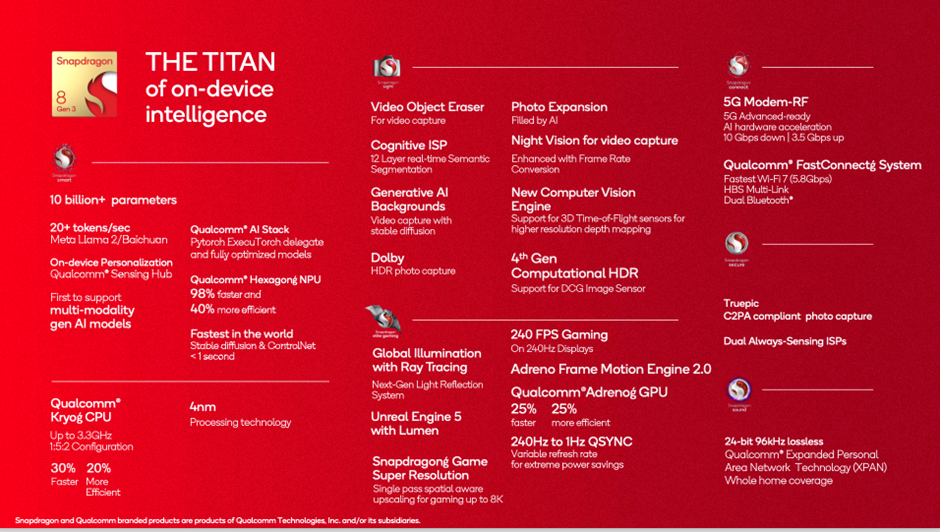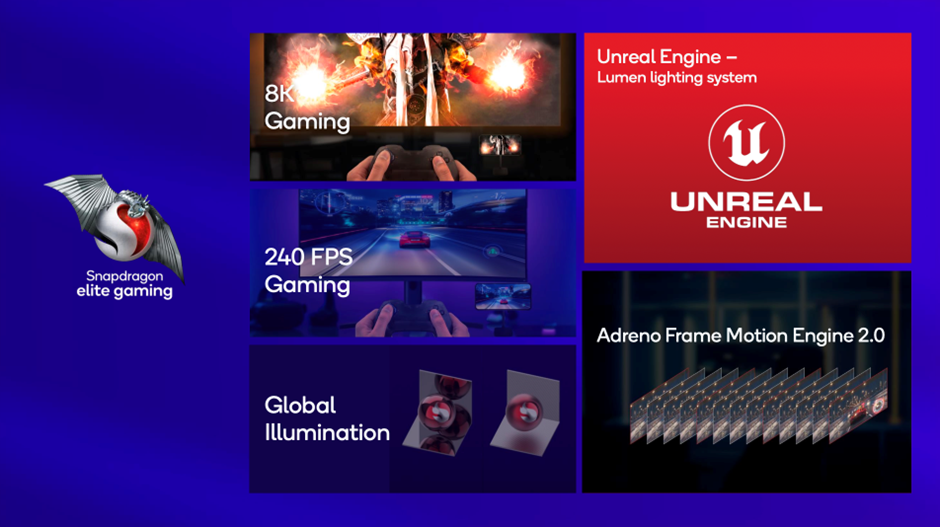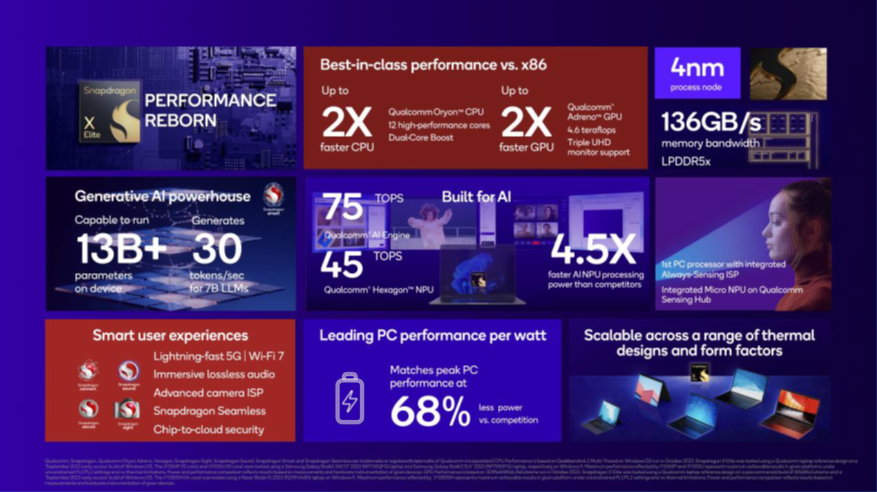Qualcomm has launched two new APs that target high-end smartphones and Windows laptops. From a marketing POV, the focus is on generative AI. The Snapdragon X Elite, a new Snapdragon design, includes a new NPU that is aimed at Windows 11 PC platforms. The Snapdragon 8 Gen 3 is the latest generation of smartphone AP, with a powerful NPU that may be getting close to the size of the GPU. Snapdragon X Elite, designed for laptops, combines a powerful CPU, GPU, and NPU along with 5G modem and Wi-Fi 7 support. Qualcomm’s strategy involves differentiation through owning their own NPU and GPU technology and customizing CPUs. They are also exploring RISC-V CPUs.
What do we think? From a marketing POV, the focus is on client-side inferencing generative AI with assistance from the cloud. If you’re going to do it, do it for everything, seems to be the message from Qualcomm with generative AI solutions that range from earbuds to laptops/PCs. Qualcomm says its AI stack is “a unified software stack for the new era of AI.”
Snapdragon 8 Gen 3 is impressive. The performance leap is right where it needs to be, the AI features will give OEMs lots to play with, and the combination of a prime core with five performance cores and two efficiency cores gives a lot of flexibility and performance. Gamers will love the improvements in FPS and Unreal Lumen support. This is also Qualcomm’s latest Windows-compatible offering (the first being in 2017).
With Snapdragon X Elite, Qualcomm is securing its spot in Windows for Arm, where other players just aren’t getting a toehold. Overall, an impressive line-up for Snapdragon Summit 2023.
Qualcomm launches a range of solutions enabling generative AI

New Snapdragon platforms introduced today put AI ‘on-device’ focusing on generative AI (G-AI). Most notable is Snapdragon X Elite, a ground-up Snapdragon design for on-device AI that adds a new NPU and renews Qualcomm’s focus on Windows 11 PC platforms. Alongside that is the latest generation of smartphone AP, the 4mn Snapdragon 8 Gen 3, which Qualcomm claims has the most powerful NPU for mobile devices, which will be used to enhance camera, gaming, sound, and connectivity experiences.
Qualcomm rules in premium Android smartphones and we understand Snapdragon 8 Gen 3 will take the lion’s share of slots in Samsung’s S24 range with China and North America assigned to Qualcomm and Samsung’s own Exynos shipping in South Korea and Japan (plus some nominal markets that don’t buy high-end phones), and the EU split still TBD.
Qualcomm says the Snapdragon X Elite PC platform outpaces competing laptop CPUs, which we take to mean MediaTek, Samsung, and possibly Nvidia, rather than Apple, but it will be interesting to benchmark.
For G-AI, quoted performance for on-device chat assistants for Windows 11 laptops is 30 tokens per second for X Elite, and image generation on a smartphone is less than a second with 8 Gen 3, using Stable Diffusion.
Other new AI platforms announced include Snapdragon Sound, which uses AI for noise cancellation, and Snapdragon Seamless, which lets devices work together across manufacturers and OSes.
Snapdragon 8 Gen 3
Snapdragon 8 Gen 3 is built from familiar blocks: the Spectre ISP, Adreno GPU, Hexagon NPU, and Kryo CPU, alongside sensor and security cores.
An impressive number of partners are working with Qualcomm to enable OEM AI features. Notable ones included Meta, with a Llama 2-based smartphone AI assistant.
The Hexagon NPU is up to 98% faster and 40% more efficient, versus the previous generation, and supports 10 billion+ parameters. Distinguishing hardware features include LP-DDR5x @ 4.8GHz, which at least for now is the fastest on-device memory in a smartphone AP.

The Spectre ISP delivers a wide range of photo enhancements including computational HDR, Photo Expansion (generating an AI image to expand the frame), Night Vision, Segmentation, and modes for Vloggers. Partners include Dolby for HDR.

The Kryo CPU combines a prime CPU at 3.3GHZ with five performance cores (2x 3.0 and 3x 3.2GHZ) and two efficiency cores (2.3GHZ) delivering a claimed 30% performance increase, abetted in part by 12MB of L3 Cache.
GPU time
The new Adreno GPU delivers a claimed 25% faster performance and 25% better power efficiency.
The big leap is in GPU upscaling. This equates to a properly impressive 240fps at 240Hz for gaming, with the Adreno Frame Motion Engine 2.0 capable of 100% fps improvements in some titles. 8K resolution is supported, and probably practical, and global illumination and ray tracing are in too.
Key partner here is Unreal and Unreal Engine 5—Lumen finally comes to smartphone APs for the first time.

Snapdragon X Elite
Inevitably a lower volume part, Snapdragon X Elite is still very interesting, especially since Arm processors are continuing to win share and could be more than 25% of the market by 2027, according to Counterpoint.

Again at 4nm, the X Elite features a new 12-core Oryon CPU, which Qualcomm claims outperforms comparable X86 cores at 1/3 of the power. This is combined with a 4.6 TFLop Adreno GPU capable of driving up to three UHD monitors. Add 136GB/s LPDDR5x and you have a powerful laptop chip. The Hexagon NPU delivers a claimed 45 TOPS, which Qualcomm says is 4.5× of competitors. This Hexagon NPU configuration handles up to 13B parameters for AI on-device or 30 tokens/s for 7B LLMs.
PCs powered by Snapdragon X Elite are expected in mid-2024.
Other hardware includes an always-on ISP and a sensor hub with a second dedicated NPU.
Given its Snapdragon lineage, it should be no surprise that X Elite also has a 5G modem along with Wi-Fi 7 support.
Strategy
Qualcomm and MediaTek have been neck and neck for smartphone AP for some time now and the Samsung split will prove crucial to who is ahead in 2024. Our money is on Qualcomm winning by a nose in 2024 but with MediaTek continuing to take slots in the mid and low parts of the market, although it won’t be by more than a percent or two.
Qualcomm has done well with differentiation, owning its own NPU and GPU technology and customizing CPUs. MediaTek continues to license the largest part of their AP, the GPU, from Arm and Imagination variously and has had an obvious two-supplier strategy for several years. With Arm’s new sales model allegedly designed to make it harder to use 3rd party IP with Arm CPUs we would be relatively unsurprised to see MediaTek have a go at buying Imagination Technologies before Imagination can reach its much-rumored IPO. See Nvidia’s reasons for wanting to buy Arm, and scale them down to MediaTek and Imagination sizes appropriately. It still makes sense.
MediaTek has been after a higher-end slot to justify its Windows on Arm project, but nothing has locked in so far. This is an area where Qualcomm is certainly far ahead.
Qualcomm’s strategy is to keep doing what they are doing while trying to corner just enough new business to edge ahead of MediaTek. Except… Qualcomm is very, very angry with Arm right now. Arm and Qualcomm are in a legal dispute over Arm’s licenses. Arm wants Qualcomm to pay higher royalties or stop using its proprietary technology without permission. The case is scheduled to go to trial late next year. This has already led to several pro-RISC-V moves from Qualcomm, most recently the launch of RISC-V Snapdragon Wear (expect a rebrand for launch) for wearables. Whether or not it comes to market this decade, we are convinced that Qualcomm has a strategy to create a RISC-VP smartphone AP, supported by Google, which is also a partner in the RISE consortium. The limit on that strategy is the general low performance of current high-end RISC-V cores, but Qualcomm is doing its best to encourage improvements.
Going forward, we expect Qualcomm to continue to invest heavily in its GPU, NPU, and other blocks. For the CPU don’t expect a change from Arm anytime soon, but we think Qualcomm’s work on RISC-V CPUs for smartphone AP will become harder and harder to hide as they build a team. This time last year, we would have put money on M&A as Qualcomm’s route to a RISC-V CPU, but now we are less sure. We think they are waiting for one or more of the RISC-V companies out there (either IP or chip) to weaken enough to be an acquihire.
Qualcomm acquired Nuvia in 2021 as part of its push into the PC processor market. Nuvia’s designs run Arm’s instruction set and had an Instruction Set Architecture (ISA) license from Arm, with certain licensing fees. This license is also known as the Architecture License Agreement (ALA) in legal documents.